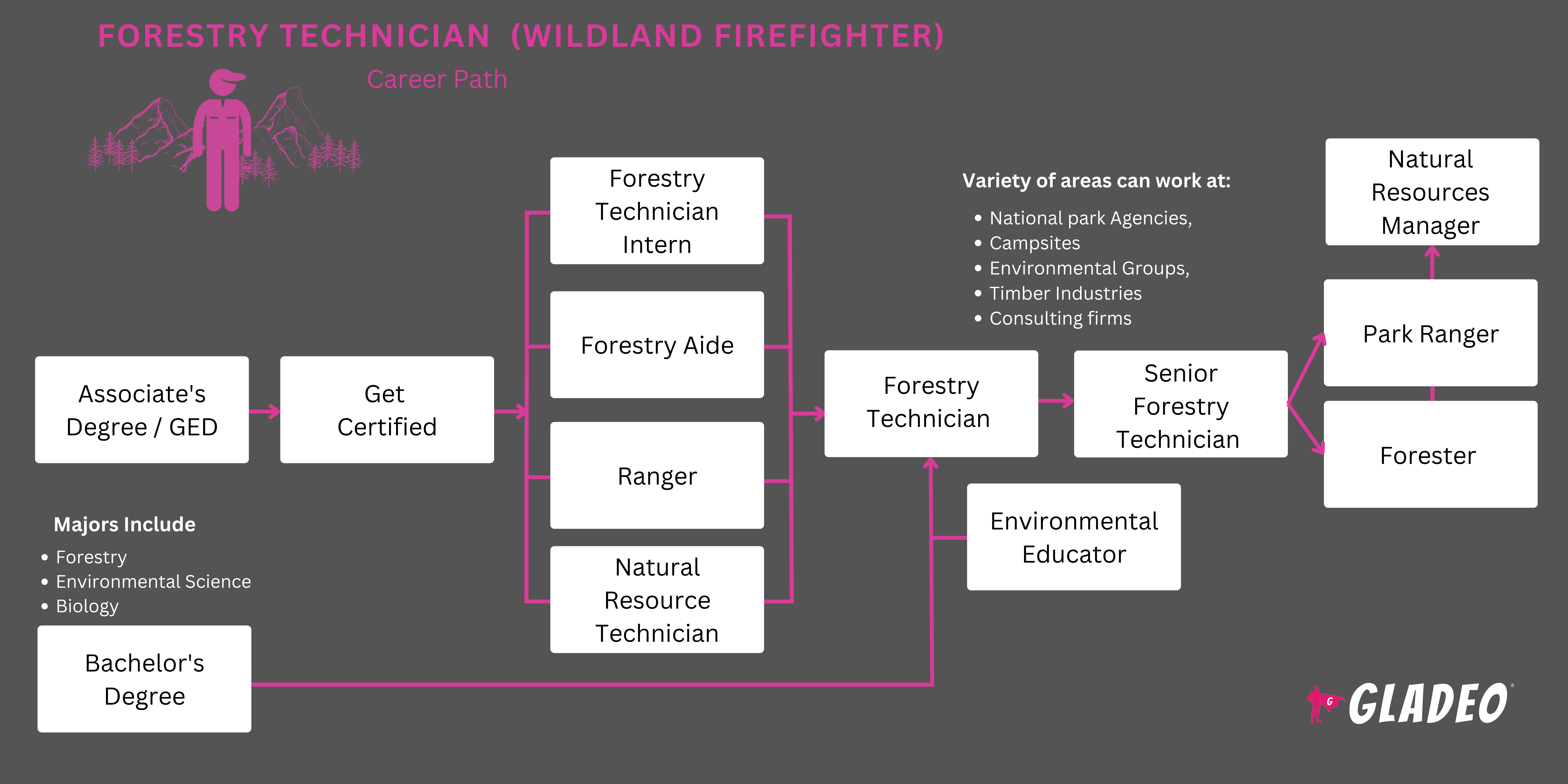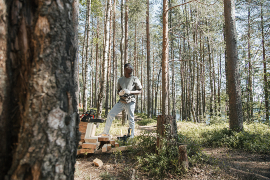Spotlights
Forest and Conservation Technicians, Biological Science Aide, Forest Technician, Forestry Aide, Forestry Technician (Forestry Tech), Resource Technician, Timber Appraiser, Wildland Firefighter
It’s hard to imagine, but roughly one-third of America is considered forested land—equaling nearly a billion acres of forests. That’s a lot of trees, and it takes a lot of Forestry Technicians (~30,000 actually) to protect them. From battling forest fires to helping with conservation efforts related to trees, soil, water, natural resources, and wildlife habitats, their roles can be multifaceted—and often unpredictable!
Every day, they serve on the frontlines, keeping an eye out for fires and fire hazards, assessing forest health, and supporting tourism and recreation industries. In the course of their duties, they collaborate with other types of firefighters, search and rescue teams, conservationists, engineers, rangeland managers, and many others.
The focus is often on protecting forests from devastating fires, and their tasks can overlap with (or even mirror) those of wildland firefighters. For example, Forestry Technicians can help establish firelines, operate equipment, engage in fire suppression activities, conduct prescribed burns (i.e., controlled fires), and help analyze how fires spread!
Note, some websites may use the terms Forestry Technician and Wildland Firefighter interchangeably. Perhaps the easiest way to think of it is that Forestry Technicians can have varying degrees of firefighting duties, depending on the training they choose to undergo. In some cases, they may end up with the same duties as a wildland firefighter.
- Protecting forests and wildlife from fires and environmental damages
- Helping trees stay healthy and pest-free
- Keeping nearby community residents and properties safe
- Preserving scenic recreational areas for the public to enjoy
Lịch làm việc
- Many Forestry Technicians work full-time, with significant overtime needed during wildfire emergencies. Some only do seasonal work, and schedules may vary by season.
Nhiệm vụ tiêu biểu
- Assess forested areas for potential fire hazards, litter, or pollution
- Post warning signs around the perimeter of dangerous areas
- Examine trees and soil for signs of disease or pests
- Plant seedlings and count trees. Mark or cut selected trees
- Apply protective insecticides, fungicides, or herbicides (may need a license to perform these tasks)
- Identify diseased or invasive trees and vegetation
- “Perform inventory cruising (Plot work such as: planting, stocking surveys, PCT, CT, and Timber inventory), vegetation control, stream buffer marking, tree planting inspections, and general duties as required for contract administration” — A&H Forestry job posting
- Use GIS/GPS to navigate forest locations and perform fieldwork
- Help to arrange contracts and perform work within contract specifications
- Assist foresters working on silvicultural projects
- Conduct patrols around wilderness boundaries on foot or using vehicles
- Coordinate recreation activities for trail hikers and forest visitors
- Respond to emergencies; work with other firefighters and first responders
- Assist injured or lost visitors; render first aid, as needed
- Construct firelines to slow or stop the spread of wildfires
- Chop down excessive brush to reduce potential fuel for fires
- Look for and put out fire flare-ups
Mid- and higher-level duties may include operating fire engines, analyzing weather and fire data, conducting prescribed burns, training and supervising others, and coordinating onsite firefighting activities. GameWarden.org lists the following Forestry Technician roles:
- Hand crew - does the “grunt work” of fireline construction and fire suppression
- Engine crew - work on a wildland fire engine
- Hotshots - specialized teams working in rough terrain
- Smokejumpers - parachute-qualified firefighters who fight hard-to-reach fires
- Helitack - Helicopter-based firefighters
- Dispatchers - work in logistics to determine resource requirements
- Lookouts - work in remote towers or as airborne spotters
Trách nhiệm bổ sung
- Perform cleaning and maintenance of vehicles, including ATVs and winter equipment such as snowmobiles
- Prepare written reports about emergency incidents
- Participate in fire and rescue drills
- Keep track of visitor numbers for use in reports
- Support law enforcement efforts and collaborate with officials as needed. Issues minor citations for violations
- Gather and report data about avalanches
- Inspect trails for safety and maintenance issues
- Educate visitors and the general public about recreation opportunities, rules and guidelines, safety topics, weather conditions, resource management, etc.
“I really do enjoy my job—the excitement of what will happen on any given day,” says Forestry Technician Sonya Lucatero. “You just don't really know what you're going to encounter in the woods and how plans will shift. You never have the same day twice.”
Kỹ năng mềm
- Accountability
- Thích nghi
- Suy luận suy diễn
- Định hướng chi tiết
- Tập trung
- Định hướng mục tiêu
- Phối hợp tay và mắt
- Sáng kiến
- Tinh ý
- Tổ chức
- Kiên nhẫn
- Preparedness
- Giải quyết vấn đề
- Tập trung vào an toàn
- Phán đoán và ra quyết định đúng đắn
- Strength, stamina, and agility
- Kỹ năng giao tiếp mạnh mẽ
- Làm việc theo nhóm
- Quản lý thời gian
Some positions, such as smokejumper, have lengthy and specific medical requirements!
Kỹ năng kỹ thuật
- Ability to carry and load up heavy objects
- Ability to operate and maintain vehicles
- Ability to safely use cutting tools
- Familiarity with biology, wildlife, geography, and math
- Sơ cứu và hô hấp nhân tạo
- Knowledge of applicable policies, regulations, and laws
- Knowledge of soil and soil amendments
- Knowledge of tree/limb braces, stakes, cables, and ties
- Knowledge of tree pesticides, fertilizers, protective tars, and related chemicals
- Outdoor survival skills
- Proper wear of personal protective equipment including helmets, gloves, and eye protection, as well as ropes, harnesses, lanyards,
- Understanding of fire safety principles and knowledge of hazards to watch out for, such as combustible materials
- Làm quen với các chiến thuật, thiết bị và thiết bị chữa cháy
- Federal, state, or local government agencies, such as:
- Bureau of Indian Affairs
- Cục Quản lý đất đai
- Forest Service (as Wildland Firefighters)
- Dịch vụ Công viên Quốc gia
- Dịch vụ Cá và Động vật hoang dã Hoa Kỳ
Forestry Technicians are constantly exposed to outdoor elements, such as hot or cold weather, wind, rain, humidity, mud, snow, etc. There are countless hazards that workers must guard against, including tripping hazards, dehydration, heat stroke, frostbite, allergens, poisonous plants, fungi, insect bites, wildlife, fires, and smoke. They have to be prepared for almost anything!
To the extent possible, Forestry Technicians should plan out their daily tasks ahead of time but must stay flexible, anticipate problems, and have a response plan. This requires ongoing training to keep skills sharp. They must be vigilant and ready to effectively handle whatever comes their way. During wildfire emergencies, they may be tagged to work very long hours until the situation is under control.
Conservation effects and sustainable management have been hot trends in the world of forestry for some time now. Sustainability efforts focus on maintaining ecosystem health, biodiversity, and the long-term viability of forests, which are invaluable for sequestering carbon dioxide.
Unfortunately, forests are at risk from wildfires which are happening more frequently and with greater intensity. Methods to combat the fires and mitigate damage include Wildland-Urban Interface management, controlled or prescribed burns, more collaborative fire management approaches, and the advancement of technological tools and solutions like remote sensing, satellite monitoring, and predictive modeling.
Forestry Technicians are typically physically active people who prefer working outdoors versus staying in an office all day. They may have grown up in rural areas, or loved camping, taking long hikes in the woods, or going hunting and fishing. Strong verbal communication skills and teamwork are essential, which may have been developed from extracurricular activities in school.
- Forestry Technicians need at least a high school diploma or GED
- A valid driver’s license is usually needed
- An associate’s degree or some college classes such as fire science, forest technology, forest ecology, wildlife management, or resource conservation can be helpful
- Class topics may include: “dendrology, forest ecology, silviculture, land surveying, aerial photo interpretation, woods safety, harvesting techniques, multiple uses of forest land, measuring forest resources, forest health, and forest management practices”
- Workers can expect to receive ample On-the-Job training
- Note, the terms Forestry Technician and Wildland Firefighter are sometimes used interchangeably. The Department of the Interior even lists the following job title: Forestry Technician (Wildland FireFighter)
- The Forest Service offers a Wildland Firefighter Apprenticeship Program
- Those who pursue a firefighting path will have to complete extra training to obtain a “Red Card.” For example, GameWarden.org notes that workers complete very short courses such as:
- Intro to Incident Command System
- Human Factors in the Wildland Fire Service
- Firefighter Training
- Intro to Wildland Fire Behavior
- In addition, they will get hands-on experience via a short field training exercise
- Candidates must be medically qualified to perform certain duties and may have to pass an annual fitness test, as well
- Red Cards must be renewed each year via Annual Fireline Safety Refresher Training
- Workers may complete additional job-specific training, such as Fire Vehicle Driver Orientation
- Technicians who apply pesticides or other chemicals may need a state license
- Forestry Technicians don’t need a college degree, but it can be helpful to complete classes in fire science, forest technology, forest ecology, wildlife management, or resource conservation.
- Future Forestry Technicians should participate in sports and physical fitness activities to get in shape
- In high school, study biology, environmental science, agronomy, forestry, and plant and soil science
- Do a Google search for local tree service providers and check out their websites. Some companies offer arborist trainee internships and seasonal work
- Participate in extracurricular activities where you can get experience outdoors, such as Girl Scouts, Boy Scouts, or local parks and recreation groups
- Go camping, hiking, or fishing. Start a garden or volunteer to help a local park’s garden
- Learn how to navigate outdoors using GPS; study how Geographic Information Systems are used for mapping
- Apply for outdoor jobs working with landscaping and tree care. Learn about common tree diseases and pests
- Look for opportunities to get field experience with government agencies, private forestry companies, conservation organizations, or research institutions.
- Get your driver’s license and consider applying for a CDL
- Talk to working Forestry Technicians to ask about their jobs. Try to speak to workers performing different duties
- Research the different roles that Forestry Technicians can fill, and decide if you want to pursue more of a firefighting role or not. If so, consider doing the Wildland Firefighter Apprenticeship Program

- You can find Forestry Technician (and Wildland Firefighter) job openings on USAJOBS and Indeed.com
- Check out the career pages of the Bureau of Indian Affairs, Bureau of Land Management, Forest Service, National Park Service, and U.S. Fish and Wildlife Service
- Take note of keywords in job postings. Tailor your resume and cover letter to include them, while highlighting your relevant education and experience
- If you don’t have the necessary experience for certain jobs, don’t give up. Keep looking for more entry-level positions until you find one that you qualify for
- Attend recruitment events. Many federal and state agencies show up at job fairs ready to hire on the spot. Come dressed nicely and prepared to ask questions and give mature responses
- If you take college courses, ask instructors or fellow students about openings they’re aware of or connections they have. Many jobs are found through networking!
- Ask working Forestry Technicians and Wildland Firefighters how they landed their jobs
- Make a list of potential personal references. Get permission to share their contact info ahead of time
- During interviews, demonstrate your knowledge of the industry and highlight your commitment to safety
- Review sample Forestry Technician interview questions to practice your responses
- Ask a friend (or your school’s career center) to help you run through some mock interviews
- Build a strong foundation of knowledge and skills, then actively seek opportunities to gain leadership and managerial experience in the forestry industry
- Forestry Technician work can be dangerous, due to risks of falling, cuts from sharp tools, dropping tree branches, exposure to inclement weather, wildlife, pests, chemicals, and potential fires. Practice outstanding safety at all times to show you’re a responsible worker!
- Forestry work can be physically demanding and may involve working in remote or challenging environments. Maintaining good physical fitness is essential
- Ask your supervisor how you can qualify for additional responsibilities. Let them know you want to move up so you can be of greater assistance
- Keep learning new things! Ask what courses you can take that would benefit them (and see if they’ll pay for the classes)
- For example, if they need someone who can spray pesticides, volunteer to do the training so you can get licensed. Or if they need someone to operate a fire vehicle, let them know you’ll take the classes to qualify!
- Be at work on time and take care of tools, equipment, and vehicles
- Work effectively as part of a team that gets the job done right, follows safety protocols at all times, doesn’t cut corners, and avoids mishaps
- Don’t be caught off-guard. Always have a contingency plan to respond to urgent situations
- Participate in professional organizations and offer to give lectures or teach workshops
- Train new workers thoroughly. Set high standards so they will learn to do the job safely
- Stay up to date on trends and industry changes that improve performance and reduce mishaps
Các trang web
- Hiệp hội Thủy sản Hoa Kỳ
- Bureau of Indian Affairs
- Cục Quản lý đất đai
- Forest Stewards Guild
- International Association of Wildland Fire
- Hiệp hội quốc tế về văn hóa Arboriculture
- Mid-America Christmas Tree Association
- Hiệp hội các chuyên gia cảnh quan quốc gia
- National Association of State Departments of Agriculture
- National Association of State Foresters
- National Christmas Tree Association
- Dịch vụ Công viên Quốc gia
- National Wildfire Coordinating Group
- National Wild Turkey Federation
- Hiệp hội quản lý cơ sở chuyên nghiệp
- Society for Range Management
- Hiệp hội Lâm nghiệp Hoa Kỳ
- Hiệp hội lâm nghiệp thương mại
- Student Conservation Association
- Hội Động vật hoang dã
- Hiệp hội công nghiệp chăm sóc cây
- Dịch vụ Cá và Động vật hoang dã Hoa Kỳ
- U.S. Forest Service
- Wildfire Today
- Wildland Firefighters Foundation
Sách vở
- Firefighter's Handbook On Wildland Fire, by William C. Teie
- On Fire: A Career in Wildland Firefighting and Incident Management Team Response, by Thomas C. Cable
- Wildland Firefighting Fundamentals, by William C. Teie and Brian F. Weatherford
Forestry Technician work can, at times, be fun, exciting, dull, or dangerous. Every day comes with its own unique set of challenges. While many people love this line of work, it is not for everyone! If you’re curious about related career fields, consider some of the below options:
- Công nhân nông nghiệp
- Người vẽ bản đồ
- Nhà khoa học bảo tồn
- Farmworker
- Firefighter
- Thanh tra phòng cháy chữa cháy
- Forester
- Người giữ sân cỏ
- Người giữ đất
- Người làm vườn
- Logging Worker
- Kỹ thuật viên nhà trẻ
- Xử lý thuốc trừ sâu
- Range Manager
- Người đốn cây
Nguồn cấp tin tức

Việc làm nổi bật

Các khóa học và công cụ trực tuyến

Kỳ vọng về mức lương hàng năm
New workers start around $60K. Median pay is $67K per year. Highly experienced workers can earn around $85K.






